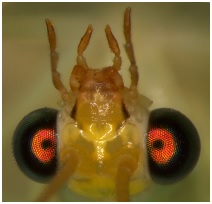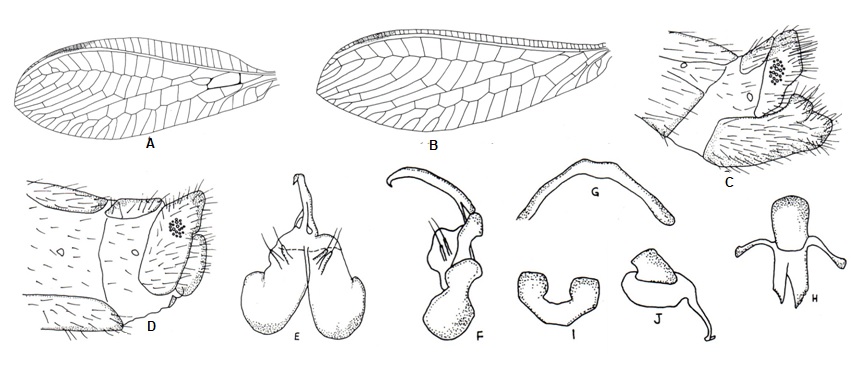Synonyms :
DISTRIBUTION : According to WaiWiki, this species is indigenous to various Asian countries like India (West Bengal, Andhra Pradesh, Gujarat, Karnataka and Uttar Pradesh), Indonesia, Japan, Pakistan including China and Taiwan. They are also found prevalent in African countries like Ethiopia, Gabon and Tanzania.Bonin Islands, Cape Varde, Central and South Africa, Chagos Islands, and Ryukyu Islands.
Diagnostic characters (General) :


DIAGNOSTIC CHARACTERS (TAXONOMIC) :

Characters : Medium lacewing; ground colour pale green.
Head : Pale green; black spot on gena; black elongated spot on lateral margin of clypeus; maxillary palpi black; labial palpi pale. Antenna pale yellow; four rows of setae on each flagellar segment, setae dark brown in colour.
Thorax : Pale green; prothorax wider than long with mid-dorsal stripe on pronotum. Legs pale green; claws brown.
Fore wing (Fig.A) : Broad; tip blunt; membrane transparent; pterostigma distinct; venation pale yellow; crossveins faintly dark; Sc and R very close towards base wide at apex; 20-22 costal veinlets; inner gradates meeting psm; im oval, apex of im cell meets base of 1st r-m crossvein or beyond.
Hind wing (Fig.B) : Smaller, boat shaped with very distinct pterostigma.
Abdomen (Fig.C, D) : Pale green.
Genitalia ♂ (Fig.E - H) : Gonarcus narrowly arched with oval side pieces but entoprocessus absent; long arcessus; paramere arms broad, space between arms sclerotized, bearing four setae on stalk-like base; gonapsis flattened and splitting distally into two prongs (Fig. H), left one being narrower, and also with long and narrow lateral arms and angularly arched tignum with indistinct acumen (Fig. G).
Genitalia ♀ : Subgenitalebilobed apically (Fig.J); spermatheca broad with short duct.
Measurement of one specimen: ♂ : Length of fore wing 12.2 mm, length of hind wing 9.9 mm.
Material examined: 2 ♂, 1 ♀ : India, West Bengal, Kalchini, 21. VIII. 2018. Coll. S. R. Dey.
REMARKS : Adams (1959) while studying the Micronesian Chrysopid, included the species under genus Chrysopa Leach along with further description of male genitalia. Ghosh (1990) treated the species under genus Anisochrysa. With the erection of genus Mallada by Hölzel (1970), Adams (1975), and Brooks and Barnard (1990), the species has been incorporated under genus Mallada by the present author.
CROPS ASSOCIATED WITH : Investigations were carried out on the host plant-mediated orientational and ovipositional behavior of Mallada boninensis towards three different host plants, cotton, sunflower, and pigeonpea. Wind tunnel studies indicated that M. boninensis males did not show any specific preference for any of the three host plants, while females showed a higher preference for cotton. The ovipositional patterns also followed a similar trend, with more eggs being laid on sunflower and cotton and fewer eggs being laid on pigeonpea, when the chrysopid adult was tested under no-choice conditions. When given a choice of all three host plants, M. boninensis followed the same pattern. On sunflower, the eggs were almost equally distributed over the tender leaves, florets, and bracts. On cotton, M. boninensis did not exhibit any such preference. On pigeonpea, very few eggs were laid those were distributed on leaves and pods, but never on flowers.
Narindah and Indrayani (1989) recorded Mallada boninensis (Okamoto) on Helicoverpaarmigera infesting cotton in Indonesia for the first time.The aphids, Aphis craccivora, Aphis gossypii and Rhopalosiphummaidis dwelling on different crop viz., cowpea, cotton, and sorghum serves as the crop with which M. boninensis is associated.
UTILITIES : Red spider mite (RSM) is an important pest causing considerable crop loss in tea, Camellia sinensisL. (O. Kuntze). Severe infestation of this mite ultimately leads to defoliation. Hence, integrated control measures were suggested for the management of O.coffeae in South India. Study were carried out to record the life cycle parameters and predatory potential of M. boninensis against the red spider mite infesting tea under laboratory conditions.
Cheng (2007) stated that M. boninensis green lace wings with their highvoracity and excellent searching ability have the potentialto prevent the development of large mite populations. They are reported to feed on aphids,cicadellids.psyllids, coccids, aleurodids, thrips, mites and eggs and young larvae of lepidopterans(Richards and Davies, 1979; Raoand Satyanarayana. 1984; Boussienguet, 1986).
The chrysopid, Mallada boninensis (Okamoto) was recorded for the first time frorn Gujarat preying on B. tabaci in cotton fields.
The larva of M. boninensis has also been reported to feed on nymphs of grape mealy bug, Maconellicoccushirsutus (Green) during its development (Anon, 1987).
The feeding potential of M. boninensis has been studied on the respective two hosts :Eggs of C. cephalonica and nymphs of B.tabaci responsible for the defoliation of cotton and tea.
The egg laying capacity and survival of M. boninensis are needed to make it an economically viable method for the mass multiplication of this species for utilizing them in an integrated pest management program.
The larvae feed on pest aphids, scales, caterpillars, spider mites etc. infesting a variety of plants (McEwen et al., 2001). Among various Mallada sps.found in the world, M. boninensis, are the important green lacewing species that have been recommended for the IPM programmes (Nehare et al., 2004).
BIOLOGY : Nymphs of Aphis craccivora, nymphs of Aphis gossypii, nymphs of Rhopalosiphummaidis, neonate of Helicoverpaarmigera, neonate of Spodopteralitura, neonate of Eariasvitellaand eggs of Corcyra cephalonica are the main food for Mallada boninensis.
M. boninensis feeds well on Corcyra cephalonica eggs, with better outcomes on sterilized eggs in comparison to unsterilized eggs and neonates.C. cephalonica can be mass reared on Jowar along with groundnut, streptomycin, vitamin complex, Na and K salts.
M. boninensis may also be reared on eggs of Aleurocanthuswoglumi and Aleurocanthusgossypii (both Whitefly species), or on neonates of Spodopteralitura, Helicoverpaarmigera (African bollworm) and Eariasvitella (Spotted bollworm).
M. boninensis Longevity and reproductive potential was best on neonates of the Spodopteralitura (Oriental Leafworm Moth aka Tropical armyworm). Nymphs of Aphis gossypii, Aphis craccivora and Rhopalosiphummaidis also have good effect on its development and its multiplication.
Mallada boninensis may also be reared on eggs of Triboliumcastaneum; the Red flour beetle (larval diet) and on a 2 : 3 mixture (by weight) of commcrcially-available yeast autolysate and honey (adult diet).
In laboratory settings, longevity of Mallada boninensis males was 62 days and 102 days for females. The mean number of eggs laid by females was 400. The optimum temperature for predation was 35°C. Individuals averagely consumed 149 larvae of the Citrus leaf miner (Phyllocnistiscitrella).
Mallada boninensis (aka Mallada desjardinsi) is an effective generalist predator, feeding on mealy bugs (Mani and Krishnamoorthi, 1987), white flies (Selvakumaran et aI., 1996), bollworms and aphids (Kabissa et al., 1996) and on nymphs of Aphis gossypii, Aphis craccivora and Rhopalosiphummaidi, blackflies, psylla and leaf miner. Biological control would be best achieved by mass rearing and seasonal colonization of M. boninensis.
In laboratory settings, longevity of Mallada boninensis males was 62 days and 102 days for females. The mean number of eggs laid by females was 400. The optimum temperature for predation was 35°C. Individuals averagely consumed 149 larvae of the Citrus leaf miner (Phyllocnistiscitrella).
Larval stages of many chrysopids cover the dorsum with debris including their own cast cuticles, remains of prey, and fragments of vegetables or other materials and such larvae are called trash carriers or debris carriers. This could be the protective mechanism for larvae against other predators (Canard and Principi, 1984). M.boninensis also exhibit this camouflaging behavior.
REFERENCES :